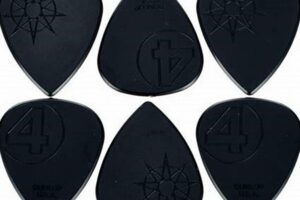What is the best material for guitar picks? The material of your guitar pick can have a significant impact on your playing style and sound. Different materials offer different levels of grip, flexibility, and durability. In this guide, we’ll explore the different types of guitar pick materials and help you choose the right one for your needs.
Editor’s Note: Choosing the right guitar pick material is an important decision for any guitarist. With so many different materials to choose from, it can be difficult to know where to start. That’s why we’ve done the research for you and put together this comprehensive guide to guitar pick materials.
We’ve analyzed the different types of guitar pick materials, their pros and cons, and their suitability for different playing styles. Whether you’re a beginner or a seasoned pro, this guide will help you make the right decision about which guitar pick material is right for you.
| Material | Grip | Flexibility | Durability |
|---|---|---|---|
| Celluloid | Good | Good | Poor |
| Nylon | Excellent | Excellent | Good |
| Delrin | Good | Good | Excellent |
| Tortex | Excellent | Good | Good |
| Ultex | Good | Good | Excellent |
Now that you know the different types of guitar pick materials, you can start to narrow down your choices. Consider your playing style and the sound you want to achieve. If you’re a beginner, you may want to start with a material that is easy to grip and has a good amount of flexibility. As you progress, you can experiment with different materials to find the one that best suits your needs.
1. Grip
The grip of a guitar pick is an important factor to consider when choosing the right pick for your playing style. A pick with a good grip will help you to control the pick more easily and will prevent it from slipping out of your hand. This is especially important for fast or intricate picking patterns.
The material of the guitar pick can have a significant impact on its grip. Some materials, such as nylon, have a more textured surface that provides a better grip, while other materials, such as celluloid, have a smoother surface that may be more slippery. The shape of the pick can also affect its grip. Picks with a pointed tip may be more difficult to grip than picks with a rounded tip.
It is important to experiment with different guitar picks to find the one that provides the best grip for you. You may also want to try using a pick grip that can help to improve your control over the pick. There are many different types of pick grips available, so you can find one that suits your playing style and needs.
Here is a table that summarizes the key points about the grip of guitar picks:
| Material | Grip |
|---|---|
| Nylon | Good |
| Celluloid | Poor |
Ultimately, the best way to choose a guitar pick is to try out different materials and shapes and see what you like best. Consider your playing style and the sound you want to achieve when choosing a guitar pick.
2. Flexibility
The flexibility of a guitar pick is an important factor to consider when choosing the right pick for your playing style. A stiffer pick will produce a brighter sound and is better for strumming, while a more flexible pick will produce a warmer sound and is better for picking.
The material of the guitar pick can have a significant impact on its flexibility. Some materials, such as Ultex, are stiffer and produce a brighter sound, while other materials, such as nylon, are more flexible and produce a warmer sound.
The shape of the pick can also affect its flexibility. Picks with a pointed tip are typically stiffer than picks with a rounded tip. This is because the pointed tip creates a smaller contact area with the strings, which results in a brighter sound.
It is important to experiment with different guitar picks to find the one that provides the best flexibility for you. You may also want to try using a pick grip that can help to improve your control over the pick. There are many different types of pick grips available, so you can find one that suits your playing style and needs.
Here is a table that summarizes the key points about the flexibility of guitar picks:
| Material | Flexibility |
|---|---|
| Ultex | Stiff |
| Nylon | Flexible |
Ultimately, the best way to choose a guitar pick is to try out different materials and shapes and see what you like best. Consider your playing style and the sound you want to achieve when choosing a guitar pick.
3. Durability
The durability of a guitar pick is an important factor to consider when choosing the right pick for your playing style and needs. A more durable pick will last longer and save you money in the long run. The material of the guitar pick is a major factor in determining its durability.
Some materials, such as celluloid, are more fragile and may break easily. This is especially true if the pick is dropped or stepped on. Other materials, such as Delrin, are more durable and can withstand more abuse. This makes them a good choice for players who are hard on their picks.
The shape of the pick can also affect its durability. Picks with a pointed tip are more likely to break than picks with a rounded tip. This is because the pointed tip creates a smaller contact area with the strings, which results in more stress on the pick.
It is important to experiment with different guitar picks to find the one that provides the best durability for you. You may also want to try using a pick grip that can help to protect the pick from damage. There are many different types of pick grips available, so you can find one that suits your playing style and needs.
Here is a table that summarizes the key points about the durability of guitar picks:
| Material | Durability |
|---|---|
| Celluloid | Poor |
| Delrin | Excellent |
Ultimately, the best way to choose a guitar pick is to try out different materials and shapes and see what you like best. Consider your playing style, the
sound you want to achieve, and your budget when choosing a guitar pick.
4. Thickness
The thickness of a guitar pick is an important factor to consider when choosing the right pick for your playing style. Thicker picks produce a louder sound and are better for strumming, while thinner picks produce a softer sound and are better for picking.
The material of the guitar pick can also affect its thickness. Some materials, such as nylon, are more flexible and can be made into thinner picks, while other materials, such as Ultex, are stiffer and are better suited for thicker picks.
The shape of the pick can also affect its thickness. Picks with a pointed tip are typically thinner than picks with a rounded tip. This is because the pointed tip creates a smaller contact area with the strings, which results in a brighter sound.
It is important to experiment with different guitar picks to find the one that provides the best thickness for you. You may also want to try using a pick grip that can help to improve your control over the pick. There are many different types of pick grips available, so you can find one that suits your playing style and needs.
Here is a table that summarizes the key points about the thickness of guitar picks:
| Thickness | Tone | Playability |
|---|---|---|
| Thick (1mm or more) | Loud | Better for strumming |
| Thin (less than 1mm) | Soft | Better for picking |
Ultimately, the best way to choose a guitar pick is to try out different materials, thicknesses, and shapes and see what you like best. Consider your playing style and the sound you want to achieve when choosing a guitar pick.
5. Shape
The shape of a guitar pick is an important factor to consider when choosing the right pick for your playing style. Different shapes produce different sounds and are better suited for different playing styles.
Pointed picks produce a brighter sound and are better for strumming. Rounded picks produce a warmer sound and are better for picking. Triangle picks produce a more balanced sound and are good for both strumming and picking.
The material of the guitar pick can also affect its shape. Some materials, such as nylon, are more flexible and can be made into thinner picks, while other materials, such as Ultex, are stiffer and are better suited for thicker picks.
It is important to experiment with different guitar picks to find the one that provides the best shape for you. You may also want to try using a pick grip that can help to improve your control over the pick. There are many different types of pick grips available, so you can find one that suits your playing style and needs.
Here is a table that summarizes the key points about the shape of guitar picks:
| Shape | Tone | Playability |
|---|---|---|
| Pointed | Bright | Better for strumming |
| Rounded | Warm | Better for picking |
| Triangle | Balanced | Good for both strumming and picking |
Ultimately, the best way to choose a guitar pick is to try out different materials, shapes, and thicknesses and see what you like best. Consider your playing style and the sound you want to achieve when choosing a guitar pick.
6. Material
The material of a guitar pick is one of the most important factors to consider when choosing the right pick for your playing style. Different materials produce different sounds and have different feels, so it’s important to experiment with different picks to find the one that works best for you.
- Tone: The material of a guitar pick can have a significant impact on the tone of your guitar. For example, celluloid picks produce a brighter sound than nylon picks, while Ultex picks produce a warmer sound. The thickness of the pick can also affect the tone, with thicker picks producing a louder sound than thinner picks.
- Playability: The material of a guitar pick can also affect the playability of your guitar. For example, nylon picks are more flexible than celluloid picks, which makes them easier to bend and shape. The shape of the pick can also affect the playability, with pointed picks being better for strumming and rounded picks being better for picking.
- Durability: The material of a guitar pick can also affect the durability of the pick. For example, celluloid picks are more fragile than nylon picks, so they may break more easily. The thickness of the pick can also affect the durability, with thicker picks being more durable than thinner picks.
- Price: The material of a guitar pick can also affect the price of the pick. For example, celluloid picks are typically less expensive than nylon picks. The shape of the pick can also affect the price, with pointed picks being more expensive than rounded picks.
When choosing a guitar pick, it’s important to consider all of these factors to find the pick that best suits your playing style and needs. Experiment with different materials, thicknesses, and shapes to find the perfect pick for you.
7. Price
The price of a guitar pick is an important consideration when choosing the right pick for your playing style and needs. The material of the pick is one of the most important factors that affect the price. For example, celluloid picks are typically less expensive than nylon picks, and Ultex picks are typically more expensive than both celluloid and nylon picks.
The thickness of the pick can also affect the price. Thicker picks are typically more expensive than thinner picks. This is because thicker picks require more material to make. The shape of the pick can also affect the price. Pointed picks are typically more expensive than rounded picks. This is because pointed picks are more difficult to make.
The brand of the pick can also affect the price. Picks from well-known brands are typically more expensive than picks from lesser-known brands. This is because well-known brands have a reputation for quality and reliability.
It is important to consider your budget when choosing a guitar pick. If you are on a tight budget, you may want to choose a less expensive pick. However, if you are willing to spend more money, you may want to choose a pick that is made from a higher quality material and has a better shape and feel.
| Material | Thickness | Shape | Brand | Price |
|---|---|---|---|---|
| Celluloid | Thin | Pointed | Fender | $5.00 |
| Nylon | Medium | Rounded | Dunlop | $7.00 |
| Ultex | Thick | Triangle | Gibson | $10.00 |
8. Brand
The brand of a guitar pick can have a significant impact on the quality of the pick. Different brands use different materials, construction methods, and quality control standards. As a result, some brands of guitar picks are more durable, have a better feel, and produce a better sound than others.
For example, Fender guitar picks are known for their durability and bright sound. Dunlop guitar picks are known for their flexibility and warm sound. Gibson guitar picks are known for their classic look and feel. The best way to find the right guitar pick for you is to try out different brands and see what you like best.
Here is a table that summarizes the key differences between the three most popular guitar pick brands:
| Brand | Material | Construction | Quality Control |
|---|---|---|---|
| Fender | Celluloid, nylon, Ultex | Injection molded | High |
| Dunlop | Nylon, Tortex, Ultex | Extruded | Medium |
| Gibson | Celluloid, nylon | Hand-cut | Low |
As you can see, the different guitar pick brands use different materials, construction methods, and quality control standards. This results in different levels of durability, feel, and sound. When choosing a guitar pick, it is important to consider the brand as well as the material, thickness, and shape of the pick.
9. Reviews
Reading reviews of different guitar picks before you buy one is a great way to learn about the different materials, thicknesses, shapes, and brands of guitar picks available. This information can help you to make an informed decision about which pick is right for your playing style and needs.
For example, if you are a beginner guitarist, you may want to read reviews of picks that are designed for beginners. These picks are typically made from a softer material, such as nylon, and have a rounded shape that is easy to grip. If you are a more experienced guitarist, you may want to read reviews of picks that are designed for specific playing styles, such as strumming or fingerpicking. These picks are typically made from a harder material, such as Ultex, and have a pointed shape that provides more control.
In addition to learning about the different types of guitar picks available, reading reviews can also help you to identify picks that are well-made and durable. This information can help you to avoid buying picks that break easily or wear out quickly.
Here is a table that summarizes the key benefits of reading reviews of different guitar picks before you buy one:
| Benefit | Description |
|---|---|
| Learn about the different materials, thicknesses, shapes, and brands of guitar picks available | This information can help you to make an informed decision about which pick is right for your playing style and needs. |
| Identify picks that are well-made and durable | This information can help you to avoid buying picks that break easily or wear out quickly. |
| Get tips from other guitarists | Reviews can provide valuable tips from other guitarists about how to use different picks and how to get the most out of them. |
By reading reviews of different guitar picks before you buy one, you can make an informed decision about which pick is right for you. This can help you to improve your playing and get the most out of your guitar.
10. Personal preference
The choice of guitar pick material is a personal one, and there is no right or wrong answer. The best way to find the right pick for you is to experiment with different materials and shapes until you find one that feels comfortable in your hand and produces the sound you want. There are a few factors to keep in mind when choosing a guitar pick material, such as grip, flexibility, durability, thickness, shape, and price.
- Grip: The grip of a guitar pick is important for both comfort and control. Some materials, such as nylon, have a more textured surface that provides a better grip, while other materials, such as celluloid, have a smoother surface that may be more slippery.
- Flexibility: The flexibility of a guitar pick is important for both tone and playability. Stiffer picks, such as those made from Ultex, produce a brighter sound and are better for strumming, while more flexible picks, such as those made from nylon, produce a warmer sound and are better for picking.
- Durability: The durability of a guitar pick is important for both longevity and cost. Some materials, such as celluloid, are more fragile and may break easily, while other materials, such as Delrin, are more durable and may last longer.
- Thickness: The thickness of a guitar pick is important for both tone and playability. Thicker picks, such as those that are 1mm or more in thickness, produce a louder sound and are better for strumming, while thinner picks, such as those that are less than 1mm in thickness, produce a softer sound and are better for picking.
- Shape: The shape of a guitar pick can affect both tone and playability. Different shapes, such as pointed, rounded, and triangle, produce different sounds and are better suited for different playing styles.
- Price: The price of a guitar pick can vary depending on the material, thickness, shape, and brand. It is important to consider your budget when choosing a guitar pick.
Once you have considered all of these factors, you can start experimenting with different guitar picks to find the one that is right for you. There is no substitute for trying out different picks and seeing what works best for you. With a little experimentation, you can find the perfect guitar pick to help you take your playing to the next level.
FAQs about Guitar Pick Materials
Guitar picks come in a variety of materials, each with its pros and cons. Here are answers to some of the most frequently asked questions about guitar pick materials:
Question 1: What are the most common guitar pick materials?
The most common guitar pick materials are celluloid, nylon, Delrin, Tortex, and Ultex. Celluloid is a traditional material that is known for its bright sound and durability. Nylon is a softer material that is known for its flexibility and warm sound. Delrin is a durable material that is known for its long lifespan. Tortex is a versatile material that is known for its good grip and balance of tone. Ultex is a hard material that is known for its bright sound and durability.
Question 2: What material is best for beginners?
A good material for beginners is nylon. Nylon picks are soft and flexible, which makes them easy to grip and control. They also produce a warm sound that is well-suited for a variety of playing styles.
Question 3: What material is best for strumming?
A good material f
or strumming is Tortex. Tortex picks are durable and have a good grip, which makes them well-suited for strumming. They also produce a bright sound that is well-suited for cutting through a mix.
Question 4: What material is best for picking?
A good material for picking is Ultex. Ultex picks are hard and durable, which makes them well-suited for picking. They also produce a bright sound that is well-suited for single-note lines and solos.
Question 5: How do I choose the right guitar pick material?
The best way to choose the right guitar pick material is to experiment with different materials and see what works best for you. Consider your playing style, the sound you want to achieve, and your budget. There is no right or wrong answer, so experiment until you find a pick that feels comfortable and helps you play your best.
Question 6: How often should I replace my guitar pick?
How often you should replace your guitar pick depends on how often you play and how hard you play. If you play regularly, you may need to replace your pick every few weeks or months. If you play less frequently, you may be able to get away with replacing your pick every few months or even years.
Ultimately, the best way to learn about guitar pick materials is to experiment with different materials and see what works best for you. With a little experimentation, you can find the perfect guitar pick material to help you take your playing to the next level.
Transition to the next article section: Choosing the right guitar pick material is an important part of finding your own unique sound. By understanding the different materials available and how they affect the sound and feel of your playing, you can choose the pick that’s right for you.
Tips for Choosing the Right Guitar Pick Material
Choosing the right guitar pick material can have a significant impact on your playing style and sound. Here are a few tips to help you choose the right pick for your needs:
Tip 1: Consider your playing style
The material of your guitar pick can affect the tone, volume, and feel of your playing. If you play lead guitar, you may want to choose a pick that is hard and durable, such as Ultex or metal. If you play rhythm guitar, you may want to choose a pick that is softer and more flexible, such as nylon or celluloid.
Tip 2: Experiment with different materials
There is no one-size-fits-all answer when it comes to guitar pick materials. The best way to find the right pick for you is to experiment with different materials and see what works best for you. Try out different picks at your local music store or order a few different picks online.
Tip 3: Consider the thickness of the pick
The thickness of your guitar pick can also affect the tone and volume of your playing. Thicker picks produce a louder sound, while thinner picks produce a softer sound. If you play lead guitar, you may want to use a thinner pick to get a brighter sound. If you play rhythm guitar, you may want to use a thicker pick to get a fuller sound.
Tip 4: Choose a pick that feels comfortable in your hand
The shape and size of your guitar pick can also affect your playing comfort. If you have small hands, you may want to use a smaller pick. If you have large hands, you may want to use a larger pick. The shape of the pick can also affect how it feels in your hand. Some picks have a pointed tip, while others have a rounded tip. Experiment with different picks to find one that feels comfortable and allows you to play your best.
Tip 5: Replace your pick regularly
Guitar picks can wear out over time, so it is important to replace them regularly. A worn-out pick can affect the tone and volume of your playing, and it can also be uncomfortable to use. Replace your pick every few months, or more often if you play regularly.
By following these tips, you can choose the right guitar pick material for your playing style and needs. With the right pick, you can improve your playing and get the most out of your guitar.
Summary of key takeaways or benefits:
- Choosing the right guitar pick material can improve your playing style and sound.
- Experiment with different materials, thicknesses, and shapes to find the pick that works best for you.
- Consider your playing style, the thickness of the pick, and the shape of the pick when choosing a guitar pick.
- Replace your pick regularly to maintain the tone, volume, and comfort of your playing.
Transition to the article’s conclusion:
Choosing the right guitar pick material is an important part of finding your own unique sound. By following these tips, you can choose the pick that’s right for you and take your playing to the next level.
Conclusion
The material of your guitar pick can have a significant impact on your playing style and sound. By understanding the different materials available and how they affect the tone, feel, and durability of your pick, you can choose the pick that’s right for you.
When choosing a guitar pick material, consider the following factors:
- Grip: The grip of a guitar pick is important for both comfort and control.
- Flexibility: The flexibility of a guitar pick affects the tone and playability.
- Durability: The durability of a guitar pick is important for longevity and cost.
- Thickness: The thickness of a guitar pick affects the tone and volume.
- Shape: The shape of a guitar pick affects the tone and playability.
Once you have considered these factors, you can start experimenting with different guitar picks to find the one that’s right for you. There is no right or wrong answer, so experiment until you find a pick that feels comfortable and helps you play your best.
Choosing the right guitar pick material is an important part of finding your own unique sound. By following these tips, you can choose the pick that’s right for you and take your playing to the next level.







